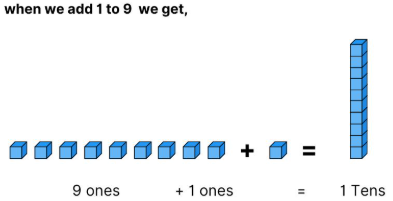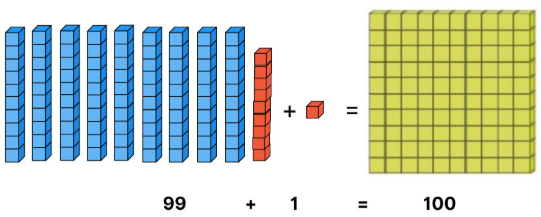Guide To Large Numbers for Class 4 [+12 Practice Worksheets]
This is a comprehensive lesson plan for teaching large numbers to grade 4 students. The lesson is designed to make the concepts easy and engage students with activities like quizzes, practice questions, worksheets, visual aids like images, and real-life examples.
Teachers can use this guide as a reference for delivering the concepts to students and engaging them in the classroom with the various questions and examples given in this page.
For parents, there are 12 downloadable practice worksheets that they can use for their kids.
In this article, you will learn:
- Large numbers - Introductions
- Learning 1 - 7 digit numbers and the different operations - comparing and ordering, expand numbers, place value and face value, etc.
Introduction to Large Numbers
As you learn large numbers, they have a pattern of place value. Here we’ll learn about the range of large numbers from 1 to 7 digits - from the smallest in this range to the largest.
Place Value and Digits
Each digit has a special place or position in a number. These places tell us what value the digit holds in the number. For instance, in the number 5,432, the place values are:
|
Thousands |
Hundred |
Tens |
Ones |
|
5 |
4 |
3 |
2 |
This pattern will help us understand why numbers like 500 and 5,000 are different.
Learning 1- to 7-digit Numbers
One-Digit Numbers
1-digit numbers are the simplest, from 1 to 9. These numbers only have the Ones place.

A 1-digit number has only one digit, like 1, 2, 3, up to 9.
Example:
- The number 7 is a 1-digit number. It stands alone, representing seven objects.
- Smallest One-Digit Number: 1
- Greatest One-Digit Number: 9
Practice Questions:
1. Which of the following is a 1-digit number?
-
10
-
9
-
11
-
20
2. How many 1-digit numbers are there in total?
-
5
-
7
-
8
-
9
3. Which of these is the smallest 1-digit number?
-
0
-
1
-
5
-
9
4. What is the largest 1-digit number?
-
8
-
9
-
10
-
7
5. Which of these numbers is not a 1-digit number?
-
7
-
12
-
5
-
9
Two-Digit Numbers
When we go past 9, we get to two-digit numbers, which go from 10 to 99. Now, we need two digits! These numbers have two places: Tens and Ones.

Example:
- The number 42 has 4 Tens and 2 Ones.
- 4 Tens means 40 and 2 Ones means 2. Together, 42 means forty-two.
- Smallest Two-Digit Number: 10
- Greatest Two-Digit Number: 99
Practice Questions:
1. What is the smallest 2-digit number?
-
1
-
10
-
11
-
9
2. What is the sum of the digits in the number 56?
-
5
-
6
-
11
-
10
3. Which of these numbers is the largest 2-digit number?
-
99
-
90
-
88
-
98
Three-Digit Numbers
Three-digit numbers range from 100 to 999. They have Hundreds, Tens, and Ones places

Example:
The number 326 has:
-
3 Hundreds = 300
-
2 Tens = 20
-
6 Ones = 6
So, 326 means three hundred twenty-six.
-
Smallest Three-Digit Number: 100
-
Greatest Three-Digit Number: 999
Practice Questions:
1. Which of these is a 3-digit number?
-
56
-
234
-
1000
-
99
2. What is the largest 3-digit number?
-
999
-
100
-
998
-
1000
3. Which number has the digit “6” in the hundreds place?
-
768
-
607
-
176
-
536
4. What is the smallest 3-digit number?
-
10
-
99
-
100
-
101
5. If you add 1 to the largest 3-digit number, what number do you get?
-
999
-
1000
-
998
-
100
Four-Digit Numbers
Moving up, four-digit numbers are from 1,000 to 9,999. This is where things start to feel BIG! Four-digit numbers are in the thousands. They have four places: Thousands, Hundreds, Tens, and Ones.
Example:
- The number 5,123 has 5 Thousands, 1 Hundred, 2 Tens, and 3 Ones.
- 5 Thousands means 5,000, 1 Hundred means 100, 2 Tens means 20, and 3 Ones means 3. In words 5,123 is written as, five thousand one hundred twenty-three.
Smallest Four-Digit Number: 1,000
Greatest Four-Digit Number: 9,999
The largest 4-digit number can be written in place value chart as follows:
|
Thousands |
Hundred |
Tens |
Ones |
|
9 |
9 |
9 |
9 |
Practice Questions:
1. Which of these is a 4-digit number?
-
987
-
10000
-
2345
-
100
2. What is the largest 4-digit number?
-
9000
-
9999
-
99999
-
10000
3. Which 4-digit number has the digit “5” in the hundreds place?
-
5348
-
3548
-
3485
-
2345
4. Which of the following 4-digit numbers has “6” in the thousands place?
-
2632
-
6321
-
3618
-
2456
5. What is the place value of “8” in the number 4872?
-
Hundreds
-
Tens
-
Thousands
-
Ones
Five-Digit Numbers
Next up are five-digit numbers, which go from 10,000 to 99,999. They’re in the ten thousands.
-
Smallest Five-Digit Number: 10,000
-
Greatest Five-Digit Number: 99,999
Example:
- The number 99,999 has 9 Ten Thousands, 9 Thousands, 9 Hundreds, 9 Tens, and 9 Ones.
- 2 Ten Thousands means 90,000, 9 Thousands means 9,000, 9 Hundreds means 900, 9 Tens means 90, and 9 Ones means 9. The largest 5-digit number 99,999 is read as:
- Ninety-nine thousand nine hundred ninety-nine.
The number 9999 can be written in the place value chart as,
|
Ten Thousand |
Thousands |
Hundred |
Tens |
Ones |
|
9 |
9 |
9 |
9 |
9 |
Practice Questions:
1. Which of the following is a 5-digit number?
-
9876
-
12478
-
129087
-
987
2. What is the largest 5-digit number?
-
9999
-
10000
-
99999
-
100000
3. What is the place value of “7” in the number 27834?
-
Tens
-
Thousands
-
Ten Thousands
-
Hundreds
4. Which of the following is the expanded form of 54210?
-
50000 + 4000 + 20 + 1
-
50000 + 4000 + 210
-
50000 + 400 + 200 + 1
-
50000 + 4000 + 200 + 10
5. If you add 1 to the largest 5-digit number, what number do you get?
-
100000
-
10000
-
99999
-
99000
Six-Digit Numbers
Six-digit numbers go from 100,000 to 999,999. These numbers are called lakhs or hundred thousands because they add the Hundred Thousands place.
- Smallest Six-Digit Number: 100,000
- Greatest Six-Digit Number: 999,999
Explanation:
- The smallest 6-digit number is 1,00,000.
- The smallest 5-digit number is 10,000, and the largest 5-digit number is 99,999.
When we add 99,999 + 1, we get 1,00,000, which is read as one lakh.
- 10 ten thousands make 1 lakh.
- The greatest 6-digit number is 9,99,999, read as Nine lakh, ninety-nine thousand, nine hundred ninety-nine.
This number can be shown in a place value chart.
|
Lakh |
Ten Thousand |
Thousands |
Hundred |
Tens |
Ones |
|
9 |
9 |
9 |
9 |
9 |
9 |
Practice Questions:
1. Which of the following is a 6-digit number?
-
9876
-
987654
-
98765
-
9876543
2. What is the place value of the digit “3” in the number 743256?
-
Thousands
-
Ten Thousands
-
Hundred Thousands
-
Hundreds
3. Which number has the digit “4” in the Hundred thousands place?
-
456783
-
543210
-
4123
-
223456
4. If you add 1 to the largest 6-digit number, what number do you get?
-
1000000
-
999999
-
100000
-
999998
5. What is the smallest 6-digit number?
-
10000
-
100000
-
1000000
-
999999
Seven-Digit Numbers
Finally, we have seven-digit numbers. They range from 1,000,000 to 9,999,999. This level is called the lakhs. These are also called Millions.
- Smallest Seven-Digit Number: 1,000,000
- Greatest Seven-Digit Number: 9,999,999
The greatest 6-digit number is 999999.
999999 + 1 = 1000000 (the smallest 7-digit number) 1000000 is read as ten lakh. 10 one lakhs give 1 ten lakh.
The greatest 7-digit number is 99,99,999 which is read as Ninety-nine lakh, ninety-nine thousand nine hundred ninety-nine.
The number 99,99,999 can be written in the place value chart as,
|
Ten Lakhs |
Lakh |
Ten Thousand |
Thousands |
Hundred |
Tens |
Ones |
|
9 |
9 |
9 |
9 |
9 |
9 |
9 |
Practice Questions:
1. If you add 1 to the largest 7-digit number, what number do you get?
-
10000000
-
99999998
-
1000000
-
9999989
2. What is the smallest 7-digit number?
-
100000
-
9999999
-
1000000
-
999999
3. Which number has the digit “4” in the Ten Lakhs place?
-
4156783
-
5543210
-
412300
-
2234561
Fun facts
1. Zero is the Hero - Zero lets us make numbers bigger, from 10 to 100 to 1,000 and beyond.
2. Counting to a Million - Counting nonstop to 1 million would take almost 12 days!
3. Stars in the Sky - There are more than 100 billion stars in our galaxy—that’s 11 digits long!
4. A Million is Huge - 1,000 groups of 1,000 make 1 million.
5. Honeybee Colonies - A single bee colony can have 20,000 to 80,000 bees!
Orchids' learning material
Click the button to download the e-book
FAQs
1. What is a three-digit number? Can you give an example?
A three-digit number has hundreds, tens, and ones. For example, 435 is read as "Four hundred thirty-five." The 3 stands for three hundreds, the 4 for forty, and the 5 for five ones.
2. How are four-digit numbers read and written?
Four-digit numbers include thousands. For example, 6294 is read as "Six thousand two hundred ninety-four." The first digit shows thousands, the second shows hundreds, the third shows tens, and the last shows ones.
3. What is the difference between a five-digit number and a four-digit number?
A five-digit number has an extra digit for ten thousands. For example, 10,000 (ten thousand) is the smallest five-digit number, and 9,999 (nine thousand nine hundred ninety-nine) is the largest four-digit number.
4. How do I read six-digit numbers?
Six-digit numbers show lakhs or hundred thousands. For example, 894,517 is read as "Eight lakhs ninety-four thousand five hundred seventeen”.
Things You Have Learned!
- Read and write numbers up to five digits accurately.
- Identify the place value and face value of digits in a number.
- Expand numbers by breaking them into their place values.
- Compare and arrange numbers in ascending and descending order.
- Form the greatest and smallest 5-digit numbers using given digits.
- Find the predecessor and successor of a given number.
CBSE Schools In Popular Cities
- CBSE Schools in Bangalore
- CBSE Schools in Mumbai
- CBSE Schools in Pune
- CBSE Schools in Hyderabad
- CBSE Schools in Chennai
- CBSE Schools in Gurgaon
- CBSE Schools in Kolkata
- CBSE Schools in Indore
- CBSE Schools in Sonipat
- CBSE Schools in Delhi
- CBSE Schools in Rohtak
- CBSE Schools in Bhopal
- CBSE Schools in Aurangabad
- CBSE Schools in Jabalpur
- CBSE Schools in Jaipur
- CBSE Schools in Jodhpur
- CBSE Schools in Nagpur
- CBSE Schools in Ahmednagar
- CBSE School In Tumkur











